Ham radio users, from teenagers to eightysomethings, are ready to communicate in the next crisis – be it a wildfire, pandemic or ‘the big one’

Glenn Morrison, president of the Desert Radio Amateur Transmitting Society, a Palm Springs-based club dedicated to everything ham radio.
Photograph: Adam Amengual/The Guardian
by Amanda Ulrich in Palm Springs
THE GUARDIAN
by Amanda Ulrich in Palm Springs
THE GUARDIAN
Sat 27 May 2023
There’s an ancient fable that Glenn Morrison, a pony-tailed, 75-year-old who lives in the California desert, likes to tell to prove a point. As the lesson goes, one industrious ant readies for winter by stocking up on food and supplies, while an aimless grasshopper wastes time and doesn’t plan ahead. When the cold weather finally arrives, the ant is “fat and happy”, but the grasshopper starves.
In this telling, Morrison is the ant, and those who don’t brace themselves for future emergencies – they’re the grasshoppers.
Morrison is in the business of being prepared. He’s the president of the Desert Rats (or the Radio Amateur Transmitting Society), a club based in Palm Springs that’s dedicated to everything ham radio.
The old-school technology has been around for more than a century. In lieu of smartphones and laptops, ham radio operators use handheld or larger “base station” radios to communicate over radio frequencies. The retro devices can range from the size of a walkie-talkie to the heft of a boxy, 20th-century VCR.
Generations after its invention, one of ham radio’s biggest draws for hobbyists is its usefulness in an emergency – think wildfires, earthquakes or another pandemic. If disaster strikes and internet or cellular networks fail, radio operators could spring into action and help with emergency response communications, and be able to keep in contact with their own networks.
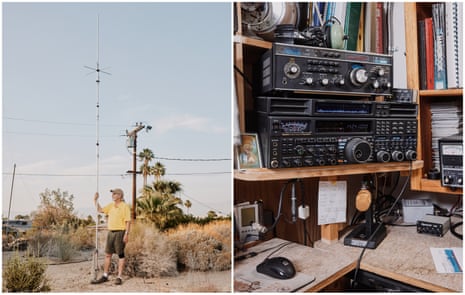
Left: Glenn Morrison standing with a U-band vertical antenna in his backyard. Right: Morrison’s main ‘rig’ in his home radio room.
Photograph: Adam Amengual/The Guardian
And the historically fringe world of ham radio is having a moment. In California, there are now nearly 100,000 licensed amateur radio operators, often simply called “hams”, and more than 760,000 across the country. That total greatly surpasses the number of hams from 40 years ago, even as newer technology has left radio in the dust.
In an era of climate crisis with more intense storms and more frequent wildfires, and other disasters such as global pandemics, ham radio is becoming a tool for some who want to regain a modicum of control.
“Ham radio,” Morrison said, “is like the original social media.”
“People aren’t prepared. And they keep thinking, ‘Well, that’s not going to happen in my lifetime.’ And it may not, but you never know.”
And the historically fringe world of ham radio is having a moment. In California, there are now nearly 100,000 licensed amateur radio operators, often simply called “hams”, and more than 760,000 across the country. That total greatly surpasses the number of hams from 40 years ago, even as newer technology has left radio in the dust.
In an era of climate crisis with more intense storms and more frequent wildfires, and other disasters such as global pandemics, ham radio is becoming a tool for some who want to regain a modicum of control.
“Ham radio,” Morrison said, “is like the original social media.”
“People aren’t prepared. And they keep thinking, ‘Well, that’s not going to happen in my lifetime.’ And it may not, but you never know.”
‘I’ve always wanted to be ready for what’s next’
On a balmy Saturday morning in Palm Springs, the thermostat already creeping its way towards 80F (27C), a few dozen people trickled into a local gymnasium, finding seats at folding tables set up below the basketball hoops. Volunteers with the Desert Rats, who had organized the makeshift radio testing day for new hams, handed out a stack of exams. If the hams passed the 35-question test, they could become licensed as entry-level amateur operators by the Federal Communications Commission.

‘Ham radio is like the original social media,’ Morrison says.
Photograph: Adam Amengual/The Guardian
One prospective ham was a high school student, a 17-year-old in a gray sweatshirt named Boaz, who took the course with his dad. Boaz first got into amateur radio through YouTube videos, he said, a year before the pandemic started.
“I’ve always wanted to be ready for what’s next,” he said. “If something happens and there’s no cell service, how am I going to talk to people?” Getting his driver’s license, his dad added, is Boaz’s next major goal.
Another newly christened ham, a college professor named Skip Fredricks who sported a black bandanna, tinted aviator sunglasses and a Star Wars T-shirt, said he was hoping to use amateur radio in the classes he teaches about drones. In disaster areas, where drones are sometimes used for search and rescue missions, the radios could help drone pilots communicate better, he said.
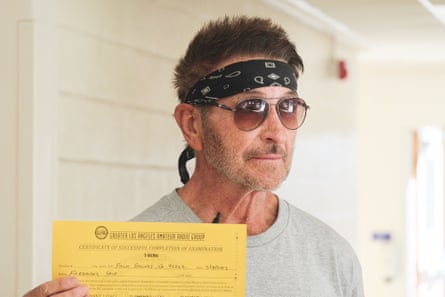
One prospective ham was a high school student, a 17-year-old in a gray sweatshirt named Boaz, who took the course with his dad. Boaz first got into amateur radio through YouTube videos, he said, a year before the pandemic started.
“I’ve always wanted to be ready for what’s next,” he said. “If something happens and there’s no cell service, how am I going to talk to people?” Getting his driver’s license, his dad added, is Boaz’s next major goal.
Another newly christened ham, a college professor named Skip Fredricks who sported a black bandanna, tinted aviator sunglasses and a Star Wars T-shirt, said he was hoping to use amateur radio in the classes he teaches about drones. In disaster areas, where drones are sometimes used for search and rescue missions, the radios could help drone pilots communicate better, he said.

Skip Fredricks, a college professor, recently obtained his radio certificate.
Photograph: Amanda Ulrich
“In very remote areas, communication is a problem,” he said. “The ham radio support is better than just walkie-talkies – and cellphones are useless in the mountains.”
Fredricks held up his new radio certificate, proving he had passed the exam, printed on a bright yellow sheet of paper. “Pretty cool, huh?” he said, looking it over. “My students will probably be impressed.”
“In very remote areas, communication is a problem,” he said. “The ham radio support is better than just walkie-talkies – and cellphones are useless in the mountains.”
Fredricks held up his new radio certificate, proving he had passed the exam, printed on a bright yellow sheet of paper. “Pretty cool, huh?” he said, looking it over. “My students will probably be impressed.”
Ham radio and ‘the big one’
Since the early 1900s, ham radio has been used as a lifeline during storms, disasters, wars and other emergencies.
Hams, a term thought to have originally been a smear targeting unskilled amateur operators, were deployed to the Caribbean in the aftermath of Hurricanes Irma and Maria in 2017. Shortwave radio also became a way for Ukrainian citizens to get news after Russia attacked communication towers last year, and Taiwanese ham radio enthusiasts have used it to prepare for potential war with China. Astronauts have even used ham radio to chat with people back on Earth.
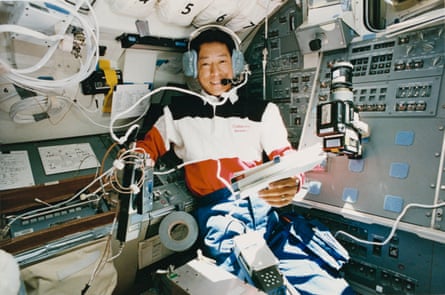
The astronaut Mamoru Mohri, wearing a headset to communicate with students and other ham operators during a mission in 1992.
Photograph: Space Frontiers/Getty Images
The radios have even cropped up in disaster movies and TV shows – most recently in scenes from HBO’s The Last of Us that show a clandestine radio operator sending messages across a zombie-ravaged country.
Living in southern California and considering the region’s web of fault lines, Morrison, the club president, often thinks about earthquakes.
“If ‘the big one’ hits, we’re not going anywhere,” he said. “You have to be self-reliant. You’re going to need food supplies and all that stuff. But also if you want Aunt Marge in Portland to know that you’re OK, then we can send her a radio gram.”
More specifically, if organizations such as hospitals, fire stations and emergency command centers call for communications assistance, qualified amateur operators can mobilize to help; many hams have “go kits” for just that purpose, with supplies including handheld radios and portable antennas.
One such emergency response took place this year, as winter storms pummeled California. In Big Bear, a remote, mountainous community that saw an onslaught of heavy snow over the past few months, amateur radio operators frequently went on the air to broadcast road closures and other local news to their networks. “I knew the roof on one market had collapsed before it was on the news because I heard it on the radio first,” Morrison said.
As an informal slogan for the American Radio Relay League, a national association for amateur radio, promises, ham radio is the ultimate backstop for “when all else fails”.
The radios have even cropped up in disaster movies and TV shows – most recently in scenes from HBO’s The Last of Us that show a clandestine radio operator sending messages across a zombie-ravaged country.
Living in southern California and considering the region’s web of fault lines, Morrison, the club president, often thinks about earthquakes.
“If ‘the big one’ hits, we’re not going anywhere,” he said. “You have to be self-reliant. You’re going to need food supplies and all that stuff. But also if you want Aunt Marge in Portland to know that you’re OK, then we can send her a radio gram.”
More specifically, if organizations such as hospitals, fire stations and emergency command centers call for communications assistance, qualified amateur operators can mobilize to help; many hams have “go kits” for just that purpose, with supplies including handheld radios and portable antennas.
One such emergency response took place this year, as winter storms pummeled California. In Big Bear, a remote, mountainous community that saw an onslaught of heavy snow over the past few months, amateur radio operators frequently went on the air to broadcast road closures and other local news to their networks. “I knew the roof on one market had collapsed before it was on the news because I heard it on the radio first,” Morrison said.
As an informal slogan for the American Radio Relay League, a national association for amateur radio, promises, ham radio is the ultimate backstop for “when all else fails”.

Left: Dorothy Strauber, member of the Young Ladies Radio League of Long Island, uses earphones to listen to her ham radio receiver in 1954. Right: Early radio ham operators circa 1919.
Photograph: Tom Maguire/Newsday RM/Bettmann Archive/Getty
Richard Norton, director of the league’s south-western division, first got hooked on ham radio in high school because he was drawn to the hobby’s technical side. Decades later, he’s seen newer hams’ interest shift to emergency preparedness. In the little town of Topanga outside Los Angeles, where Norton lives, many residents have thought about what they would do during an earthquake or wildfire if cell signal was lost, he said.
One answer? Get a ham radio.
“Even when cellphone systems go down, our ham systems generally are working and we can communicate,” he said.
Richard Norton, director of the league’s south-western division, first got hooked on ham radio in high school because he was drawn to the hobby’s technical side. Decades later, he’s seen newer hams’ interest shift to emergency preparedness. In the little town of Topanga outside Los Angeles, where Norton lives, many residents have thought about what they would do during an earthquake or wildfire if cell signal was lost, he said.
One answer? Get a ham radio.
“Even when cellphone systems go down, our ham systems generally are working and we can communicate,” he said.
‘Working the world’
From a hushed neighborhood tucked into the base of desert mountains, about 10 miles down the road from downtown Palm Springs, Morrison took a seat at his desk and “worked the world”. Spinning a large black dial on the face of a bulky base station radio, he tuned into a realm of static and distant, garbled voices. He strained to listen, parsing faint words, then pulled forward a gold microphone.
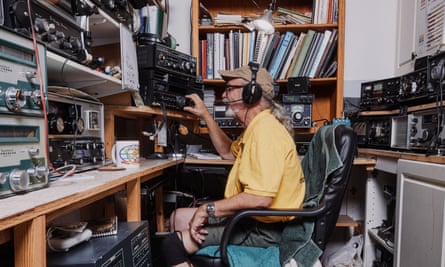
Morrison listening for contacts at his home.
Photograph: Adam Amengual/The Guardian
“Uh, Whiskey, Bravo, six, Romeo, Lima, Charlie,” Morrison said into the static, adopting the upbeat lilt of a radio DJ. The illogical string of words represents WB6RLC, his call sign, or the unique signature assigned to each ham that inevitably becomes as important as a name. Morrison’s sign was printed in bold letters on his hat, and the back of his T-shirt proudly displayed the Desert Rats club logo: a grinning rodent, its tail wrapped around a radio antenna.
Still spinning the radio dial, Morrison stumbled into a perfunctory conversation between someone around the general Nevada and Utah “call area” (the designation for where a radio license was issued) and a man in Barcelona.
“That’s how you just tune around and find somebody,” Morrison said happily. “And oh, look, he’s in Barcelona.”
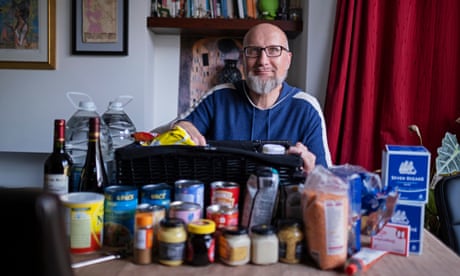
‘Everyone should prep’: the Britons stocking up for hard times
On a computer monitor connected to his radio, Morrison pulled up a comprehensive list of 215 countries, territories and other areas he’s “worked”, or contacted, from this small town in southern California: Argentina. Australia. Algeria. American Samoa. “And those are just the A’s,” he said.
Around Morrison’s one-story home, everything revolves around radio. Desert Rats sketches and maps adorn the walls. A tangle of antennas sprouts from the corner of his roof. The camper van parked in his driveway is equipped with a “mobile station” radio for any necessary on-the-go calls. There are radios in every room of his house, save for the guest bathroom.
And Morrison’s main radio room, where he overheard the Barcelona conversation, is the crown jewel. The small space attached to his garage has a command center-style feel, with an entire wall devoted to dozens of vintage radios, some over a hundred years old, that Morrison sources from flea markets and friends.
“Sometimes they just find me,” he added.
“Uh, Whiskey, Bravo, six, Romeo, Lima, Charlie,” Morrison said into the static, adopting the upbeat lilt of a radio DJ. The illogical string of words represents WB6RLC, his call sign, or the unique signature assigned to each ham that inevitably becomes as important as a name. Morrison’s sign was printed in bold letters on his hat, and the back of his T-shirt proudly displayed the Desert Rats club logo: a grinning rodent, its tail wrapped around a radio antenna.
Still spinning the radio dial, Morrison stumbled into a perfunctory conversation between someone around the general Nevada and Utah “call area” (the designation for where a radio license was issued) and a man in Barcelona.
“That’s how you just tune around and find somebody,” Morrison said happily. “And oh, look, he’s in Barcelona.”

‘Everyone should prep’: the Britons stocking up for hard times
On a computer monitor connected to his radio, Morrison pulled up a comprehensive list of 215 countries, territories and other areas he’s “worked”, or contacted, from this small town in southern California: Argentina. Australia. Algeria. American Samoa. “And those are just the A’s,” he said.
Around Morrison’s one-story home, everything revolves around radio. Desert Rats sketches and maps adorn the walls. A tangle of antennas sprouts from the corner of his roof. The camper van parked in his driveway is equipped with a “mobile station” radio for any necessary on-the-go calls. There are radios in every room of his house, save for the guest bathroom.
And Morrison’s main radio room, where he overheard the Barcelona conversation, is the crown jewel. The small space attached to his garage has a command center-style feel, with an entire wall devoted to dozens of vintage radios, some over a hundred years old, that Morrison sources from flea markets and friends.
“Sometimes they just find me,” he added.
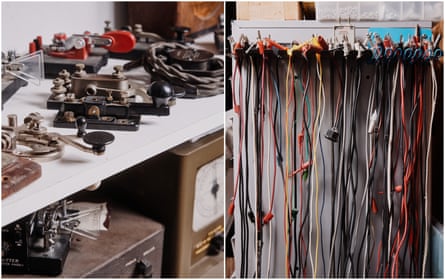
Morse code keyers and cables in Morrison’s home.
Photograph: Adam Amengual/The Guardian
Beyond using the radios for emergency communications, hams find meaning in the hobby for its own sake, and in the almost-instant network it provides. Every Monday night, the Desert Rats host a radio “net”, similar to a public conference call, where amateur operators check in and go through a simple verbal roll call of names and call signs. That type of basic welfare check was particularly important three years ago, during the very first isolating, stay-at-home phase of the pandemic.
“It gave me something to do,” Morrison said. “I’d go to my radio shack in the garage, flip on the radio and find somebody, God knows where, to talk to.”
More than an ‘old guys’ club’
Back in the Palm Springs gymnasium, volunteers with the Desert Rats graded exams, their own handheld radios holstered at the hip. Annie Larson, head of membership for the club, buzzed around the room’s periphery, glancing at some of the complex test questions about signal frequencies and the properties of radio waves. “I don’t know if I would pass today,” she joked.
Larson, who recently turned 80, has been a licensed ham for more than a decade, but she doesn’t think of herself as a “tech-y” person. “I’m just interested in being able to take care of myself in an emergency,” she said.
Larson grew up in Idyllwild, a small town lodged in the mountains that loom above Palm Springs. The community, heavily wooded and right on the doorstep of Mount San Jacinto state park, is often threatened by wildfires. A few years ago, as one blaze moved closer and closer to the town, Larson ignored local evacuation warnings and stayed behind with a few park rangers. Having her radio with her was a great reassurance.
Beyond using the radios for emergency communications, hams find meaning in the hobby for its own sake, and in the almost-instant network it provides. Every Monday night, the Desert Rats host a radio “net”, similar to a public conference call, where amateur operators check in and go through a simple verbal roll call of names and call signs. That type of basic welfare check was particularly important three years ago, during the very first isolating, stay-at-home phase of the pandemic.
“It gave me something to do,” Morrison said. “I’d go to my radio shack in the garage, flip on the radio and find somebody, God knows where, to talk to.”
More than an ‘old guys’ club’
Back in the Palm Springs gymnasium, volunteers with the Desert Rats graded exams, their own handheld radios holstered at the hip. Annie Larson, head of membership for the club, buzzed around the room’s periphery, glancing at some of the complex test questions about signal frequencies and the properties of radio waves. “I don’t know if I would pass today,” she joked.
Larson, who recently turned 80, has been a licensed ham for more than a decade, but she doesn’t think of herself as a “tech-y” person. “I’m just interested in being able to take care of myself in an emergency,” she said.
Larson grew up in Idyllwild, a small town lodged in the mountains that loom above Palm Springs. The community, heavily wooded and right on the doorstep of Mount San Jacinto state park, is often threatened by wildfires. A few years ago, as one blaze moved closer and closer to the town, Larson ignored local evacuation warnings and stayed behind with a few park rangers. Having her radio with her was a great reassurance.

Annie Larson has been a licensed ham for more than a decade.
Photograph: Adam Amengual/The Guardian
“I could listen to it at night and just leave it on,” she said, instead of needing to constantly check her phone. “If something came up, I was available.”
While amateur radio used to be something of a boys’ club (and “it still is a little bit”, she added), Larson said she sees more female operators today; about a quarter of those at the Palm Springs testing day were women. And with the wide-ranging impacts of the climate crisis, Larson thinks the hobby is relevant for all.
“People used to think it was like this old guys’ club, guys just putzing around,” she said. “But it really is important, because the population is increasing and there are many more disasters.”
Fortunately, within the Desert Rats club, hams remain a tight-knit bunch. As the latest batch of radio operators received their certificates after the testing day, some were emotional as they walked out into the desert heat. Morrison stood by the exit, congratulating and shaking hands with each person.
“We’ll catch you on the air,” he called behind them.
“I could listen to it at night and just leave it on,” she said, instead of needing to constantly check her phone. “If something came up, I was available.”
While amateur radio used to be something of a boys’ club (and “it still is a little bit”, she added), Larson said she sees more female operators today; about a quarter of those at the Palm Springs testing day were women. And with the wide-ranging impacts of the climate crisis, Larson thinks the hobby is relevant for all.
“People used to think it was like this old guys’ club, guys just putzing around,” she said. “But it really is important, because the population is increasing and there are many more disasters.”
Fortunately, within the Desert Rats club, hams remain a tight-knit bunch. As the latest batch of radio operators received their certificates after the testing day, some were emotional as they walked out into the desert heat. Morrison stood by the exit, congratulating and shaking hands with each person.
“We’ll catch you on the air,” he called behind them.
No comments:
Post a Comment